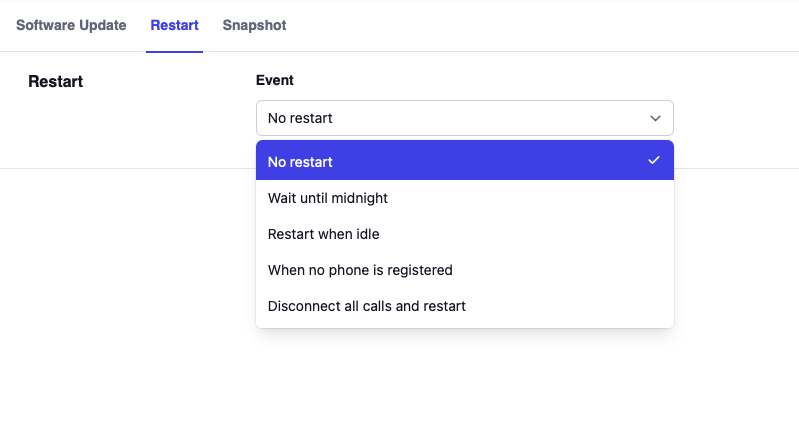PBX Reboot
Rebooting the System Using the PBX Web GUI
You can restart the PBX from the web interface by navigating to Admin Settings → Maintenance → Restart.
Available Reboot Options
-
No reboot: The system will not restart or reboot automatically. You will need to reboot/restart the system manually.
-
Wait until midnight: The system will reboot/restart at midnight.
-
Restart when idle: The system will wait until there are no active calls before rebooting. This check is performed every 15 minutes, so depending on when this setting is applied, it may take anywhere between 1-15 minutes for the reboot/restart to occur.
-
Disconnect all calls and restart: The system will drop all active calls and then reboot/restart immediately.
-
When no phone is registered: This option is important for high availability configurations. You can shut down all registrations on the primary server, allowing phones to use backup registration for new calls, and then the PBX can safely restart.
Restart Type
For every option above except No reboot, you have two restart type options:
- End the PBX process: Only the PBX process is restarted (software restart).
- Reboot Server: The entire server is rebooted (full system restart).
- Version 69
- Version 70


Important: A full server reboot will also shut down other services that are running on the same server.
Reboot Using Operating System Terminals
Linux
Restart the PBX service:
systemctl restart pbx
Or stop and start separately:
systemctl stop pbx
systemctl start pbx
Windows
Using Services Manager
- Right-click My Computer (or This PC)
- Click Manage
- Click Service Applications, then click Services
- From the right-hand pane, locate and click PBX
- Click Restart
Using Command Line
The system can be stopped and restarted from the command line:
- Right-click on CMD (in Windows search field) and select "Run as Administrator"
- To stop the service:
net stop pbx - To start the service:
net start pbx
Troubleshooting PBX Reboot Issues
Windows Issues
Missing DLL File Error
If you receive a msvcr120.dll or other .dll file missing error (and the file is not present in your PBX folder), download the appropriate version:
After downloading, place the DLL file in the PBX folder and restart the service as described above.
Linux Issues
Segmentation Fault
If you encounter a segmentation fault, find and delete all index files from within the PBX folder:
find . -name index -print
rm -Rf extlog/index
rm -Rf cdr/index
rm -Rf cdri/index
rm -Rf cdre/index
rm -Rf cdrt/index
rm -Rf recs/index
rm -Rf chat/index
rm -Rf emails/index
rm -Rf weblogin/index
rm -Rf chist/index
Starting the Service with Debug Logging
If you need to debug or troubleshoot issues preventing the Vodia PBX from starting, you can manually start the system with logging enabled:
Standard Debug Start
- Navigate to the Vodia PBX working directory
- Run the following command:
Windows:
.\pbxctrl.exe --dir . --no-daemon --log 9
Linux:
./pbxctrl --dir . --no-daemon --log 9
This will start the service at log level 9, which provides detailed diagnostic information to help identify issues preventing the service from fully initializing.
Ignoring Database Corruption
If the PBX reports a database error when starting, try starting it with the --ignore-corrupt flag:
Windows:
.\pbxctrl.exe --ignore-corrupt --dir . --no-daemon --log 9
Linux:
./pbxctrl --ignore-corrupt --dir . --no-daemon --log 9
The --ignore-corrupt flag should only be used for diagnostic purposes. If database corruption is present, it should be addressed properly rather than ignored in production environments.
Best Practices
- Plan maintenance windows: Schedule reboots during off-peak hours to minimize disruption
- Use "Restart when idle": For production systems, this option ensures no active calls are interrupted
- High availability setups: Use the "when no phone is registered" option to ensure seamless failover
- Monitor logs: When troubleshooting, always review logs at level 9 for detailed diagnostics
- Backup before major updates: Always ensure you have recent backups before performing system maintenance. Refer to Backups.